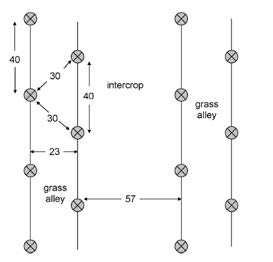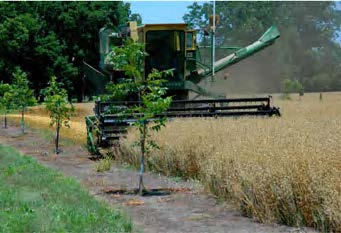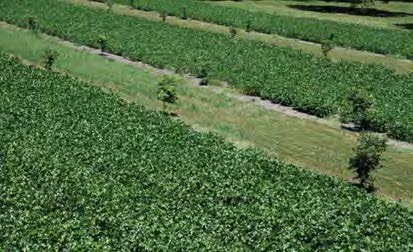AgEBB-MU CAFNR Extension
Green Horizons
Volume 23, Number 2
Spring 2019
Agroforestry
Species Spotlight: Pecan Carya illinoinensis
By Michael Gold | University of Missouri Center for Agroforestry
The pecan (Carya illinoinensis) is a species of hickory native to northern Mexico and the southern United States. "Pecan" comes from an Algonquian word variously referring to pecans, walnuts and hickory nuts requiring a stone to crack. As of 2014, the U.S. produced 264.2 million pounds of pecans, with 75% of the total crop produced in Georgia, New Mexico and Texas. Pecans can be grown from USDA hardiness zones approximately 5 to 9, and grow best where summers are long, hot and humid. The northern limit of the commercial range of pecan is located in Missouri, just north of Interstate I-70.
Pecan is a large, beautiful tree that produces bountiful crops of delicious nuts. The largest member of the hickory family, pecan trees often grow to a height of more than 70 feet with a spread of greater than 80 feet. Pecans have large, pinnately compound leaves with each leaf bearing seven to 13 leaflets. Nuts are borne on branch terminals in clusters of two to five. A fleshy green husk surrounds the nut during the growing season but splits open in October to reveal a light brown nut streaked with black mottles. As husks dry and wither, nuts fall freely from the tree. Pecan nuts vary widely in size, shape and shell thickness. Seedling pecan trees often produce small, thick-shelled nuts while trees grafted to improved cultivars produce large, thin-shelled nuts.
Multipurpose Trees
In the home landscape, these long-lived and sturdy trees provide ample shade and bright yellow fall color. Wildlife conservationists appreciate the food and cover pecan trees produce for squirrels, turkeys and deer. In many areas of Missouri, wild pecan trees have been brought under cultivation to provide farmers with an additional source of income. In addition, pecan cultivars can be grown in commercial orchards using alley cropping designs in the early years to offset initial costs of production.
Food and Wood
Pecan can be eaten fresh or used in cooking, particularly in sweet desserts, such as pecan pie and praline candy. Pecan wood is used in making furniture and wood flooring, as well as a flavoring fuel for smoking meats.
Soil Requirements
Plant pecan trees in deep, well-drained soils. Native pecans grow primarily in the deep alluvial soils found along major rivers and streams. These soils are characterized by a clay loam to sandy loam texture with good internal drainage. Pecan trees will grow and thrive in soils that range from slightly acid to slightly basic (pH 6.0 to 7.5), grow in the major floodplains of Missouri and are tolerant to seasonal flooding.
Cultivar Selection and Recommended cultivars
Selecting the proper cultivars for your particular locality will help ensure your pecan tree planting will be successful. When choosing pecan cultivars, several key characteristics should be considered, including: Length of growing season; Winter hardiness; Productivity; Flowering and pollination; and Nut size and quality.
Establishing Pecan Trees in Orchards or Alley Cropping
Orchard grown pecans trees should be planted 30 to 35 feet apart. Alley cropped pecans can be planted in a double row configuration to maximize the area for intercrop (e.g., wheat, corn, soybeans) production. See Figure 1 - Double row pecan alley cropping.
 |
Fig. 1. Double row planting for pecan orchards. Distances in ft. Tree locations marked by circles. |
Length of growing season
Pecan trees use the entire growing season to develop and mature their nut crop. Summer heat, especially high nighttime temperatures, is necessary for proper nut development. Unusually cool summers will result in a delay of nut maturity. A pecan cultivar must produce plump, well-filled nuts before the first fall freeze. Nut maturity in pecan is indicated by the splitting of the shuck and separation of nut from shuck.
Winter hardiness
"Northern" pecan cultivars, originating in the northern-most reaches of the pecan's natural range, have proven cold hardiness and are best adapted to growth in Missouri.
Seedlings and Cultivars
Seedling pecan trees are widely available from nurseries or the Missouri Department of Conservation. Desired cultivars should be grafted to seedling trees 2 to 3 years after establishment. Nut production should begin 4 to 6 years after grafting. Starting a pecan planting with seedlings offers the advantages of low initial costs and the opportunity to establish cultivars not available from commercial nurseries. Disadvantages include a delay in the onset of nut production and the expense of grafting your trees.
Care of Bearing Trees
Healthy, vigorous trees produce the highest quantity and quality of pecans. Maintaining a strong growing tree is the best defense against attacks from insects and disease. Water, fertilizer and pest control are all important for healthy tree growth. Insect and disease problems can severely limit the nut production of a pecan tree although no pests are serious enough to cause tree death. A permanent groundcover of cool-season grasses and legumes should be established in the bearing pecan orchard. Keep this permanent groundcover mowed throughout the growing season. In the home orchard, a wellkept lawn grass serves as the groundcover.
 |
Fig. 2. Double row pecan planting four years after tree establishment |
Nutrition and Flavor
Pecans are a good source of protein, fiber and heart-healthy fats, pecans are rich in ellagic acid, which may prevent certain cancers. They have also been linked to fewer heart attacks in several large studies. The USDA ranks pecans as one of the best sources of antioxidants (and the highest among nuts). Northern pecans are smaller and sweeter than the jumbo-sized hybrid nuts grown in the southern United States. This richer, more buttery flavor is due to the higher content of monounsaturated and polyunsaturated oils. Chefs across Missouri, and even New York-based food writers, have commented on the difference in flavor from Missouri-grown pecans.
 |
Fig. 3. Double row pecan planting two years after tree establishment |
For more information on pecan alley cropping, propagation and management, explore the print resources available at the Center for Agroforestry's webiste: www.CenterforAgroforestry.org/pubs/ where you'll find the following Agroforestry in Action infosheets:
- "Growing Pecans in Missouri"
- "Propagating Pecan and Black Walnut"
- "Why Pecans: NUTrition and Your Health"
and many others.
